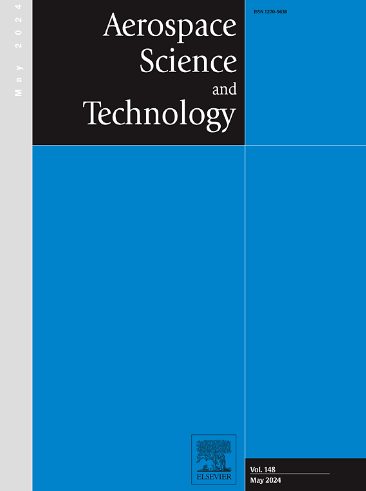Quasi-static compression response of a novel multi-step auxetic honeycomb with tunable transition strain
IF 5
1区 工程技术
Q1 ENGINEERING, AEROSPACE
引用次数: 0
Abstract
Auxetic honeycombs with multi-step deformation have received widespread attention due to their multifunctionality and superior mechanical properties. To improve the tunability of the auxetic honeycomb, a novel multi-step auxetic honeycomb (MSAH) is proposed by combining star-rhombic parts with crossed thin walls. MASH is characterized by multi-step deformation, and its stress-strain curve has three significant plateau stages. The strain during the transition between different deformation steps can be adjusted by designing unit cells with different geometrical parameters. In the compression process, the ordered contact of the cell walls of MASH is the critical reason for realizing the multi-step deformation. The quasi-static compression finite element model of MASH is established and verified by experiments. Quasi-static compression response and deformation mechanism of MASH are studied. Then, the effects of geometrical parameters on the compression response of MASH are investigated. The results show that the wall thickness has a greater effect on the compressive stress, and the cell-wall angle determines the deformation mode of MASH. Furthermore, the transition strain of MASH is theoretically analyzed and verified by numerical simulations. This study provides a reference for designing multi-step deformation honeycombs and applying multi-stage energy absorbers.
具有可调过渡应变的新型多级辅助蜂窝的准静态压缩响应
具有多级变形的助熔蜂窝因其多功能性和优异的机械性能而受到广泛关注。为了提高辅助蜂窝的可调性,我们提出了一种新型多级辅助蜂窝(MSAH),它将星形菱形部件与交叉薄壁结合在一起。MASH 具有多级变形的特点,其应力-应变曲线有三个重要的高原阶段。通过设计具有不同几何参数的单元格,可以调整不同变形步骤之间过渡阶段的应变。在压缩过程中,MASH 单元壁的有序接触是实现多级变形的关键原因。本文建立了 MASH 的准静态压缩有限元模型,并通过实验进行了验证。研究了 MASH 的准静态压缩响应和变形机理。然后,研究了几何参数对 MASH 压缩响应的影响。结果表明,壁厚对压缩应力的影响较大,细胞壁角度决定了 MASH 的变形模式。此外,还对 MASH 的过渡应变进行了理论分析和数值模拟验证。这项研究为设计多级变形蜂窝和应用多级能量吸收器提供了参考。
本文章由计算机程序翻译,如有差异,请以英文原文为准。
求助全文
约1分钟内获得全文
求助全文
来源期刊

Aerospace Science and Technology
工程技术-工程:宇航
CiteScore
10.30
自引率
28.60%
发文量
654
审稿时长
54 days
期刊介绍:
Aerospace Science and Technology publishes articles of outstanding scientific quality. Each article is reviewed by two referees. The journal welcomes papers from a wide range of countries. This journal publishes original papers, review articles and short communications related to all fields of aerospace research, fundamental and applied, potential applications of which are clearly related to:
• The design and the manufacture of aircraft, helicopters, missiles, launchers and satellites
• The control of their environment
• The study of various systems they are involved in, as supports or as targets.
Authors are invited to submit papers on new advances in the following topics to aerospace applications:
• Fluid dynamics
• Energetics and propulsion
• Materials and structures
• Flight mechanics
• Navigation, guidance and control
• Acoustics
• Optics
• Electromagnetism and radar
• Signal and image processing
• Information processing
• Data fusion
• Decision aid
• Human behaviour
• Robotics and intelligent systems
• Complex system engineering.
Etc.
 求助内容:
求助内容: 应助结果提醒方式:
应助结果提醒方式:


